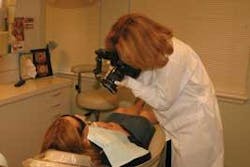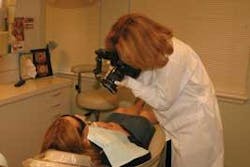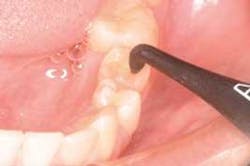The bread and butter of a restorative practice
Jeffrey Hoos, DMD
When dentists consider the clinical aspects of dentistry, their focus should always begin with the quality of a restorative material and its successful long-term application. The materials must be easy to use and provide beautiful, functional restorations. The combination of beauty, research, and ease of application ultimately leads to good business, which means success for the doctor and the team. Quality composite restorations are a balancing act between the art, science, and business of dentistry.
The skills we learn in dental school are based on science and attaining technical competence. When I graduated in 1978, there was no training on how to manage a dental practice, and certainly nothing was discussed about delivering timely and efficient patient care. I am not suggesting that we compromise quality in favor of speed. However, I do suggest that by using the correct diagnostic skills, using products correctly, and honing your clinical skills, dentists can increase their speed without sacrificing quality.
G.V. Black gave us the clinical basics for cavity design when the materials that were available required specific consideration to ensure their longevity. We have entered a new generation of time-proven restorative materials that call for another level of understanding. We have an obligation to our patients to provide high-quality adhesive dentistry that is beautiful, functional, and completed in a timely manner. No patient ever asks for a procedure to take longer than necessary.
In most clinical practices, the re-care appointment is where most follow-up diagnosis occurs. In our practice, we emphasize good diagnostic and communication skills among our hygienists. Patients spend most of their clinical time with their hygienists. The hygienist is a trusted caregiver that patients look to for information and guidance. We need to give these clinical professionals the tools they need to make the proper diagnosis and to impart that information to patients.
What tools are available besides a sharp explorer, perio probe, and mirror? X-rays and intraoral cameras are staples in the dental office, but a clinical exam augmented by the use of loupes and a technology called DIAGNOdent take your skills to the next level. The other technology is the use of a digital camera that allows patients to see things with wonderful clarity.
The Kavo DIAGNOdent allows for co-diagnosis, a phrase coined by Bob Markley. This tool gives patients the opportunity to understand what is going on in their mouths. The DIAGNOdent can detect decay in its beginning phase; therefore, the dentists can restore their patients' teeth using conservative, less invasive adhesive dentistry. Dr. Ray Bertolotti talks about putting tooth structure in the "tooth bank" and that "Dentistry is the only medical profession that constantly amputates body parts."
The DIAGNOdent is a perfect co-diagnosis tool for hygienists when used properly. One of the most low- tech devices a hygienist and dentist can use is a large mirror. We want the patient to see what we see and hear what we hear. Show the device to the patient and then give a brief explanation about its technology. When the DIAGNOdent is placed on virgin tooth structure, it gives a base line reading. Show this reading to the patient. Dry the teeth off, and then put a cheek retractor in place. This must all be done before the prophy because any green prophy paste will change the readings. Educating your hygiensts about the proper use of the DIAGNOdent is paramount. Existing composite restorations will give an incorrect reading.
The patient will have the opportunity to see the change in reading. The most important thing is that the device be used in a positive context. The hygienist could say, for example, "Mrs. Smith, we can see that overall your teeth have no decay. Only one tooth may be a problem and we will have the doctor check it for you." It's important that primary dental caregivers understand why patients agree to restorations. Consumers buy because they understand the benefits of procedures, not because of the features of a product. This is true for all "buying" situations. All benefit statements must include the word "you." If decay is found, discuss how conservatively the tooth may be repaired with the patient: "Mrs. Smith, since we found your decay early, you will be able to save lots of tooth structure." As soon as the patient has agreed to the treatment, the hygienist may easily check to see if the dentist can do a simple procedure at this appointment. The doctor's schedule should be up in each room, or if the office is computerized, readily available for the hygienist to look up.
The most important consideration is to respect your patients' time and not force them to return to the office a second time. In our office, because of the number of dentists and hygienists we employ, we have a day coordinator. The day coordinator is an assistant who is responsible for directing the "traffic" in the office. This position more than pays for itself with increased production and decreased confusion. Never offer the patient the opportunity to stay on to complete treatment until you are certain the time is available. Look for windows of opportunity during breaks from other procedures. For example, one patient may require a long anesthetic waiting period. Another window may be during a lengthy procedure where that patient needs a rest or bathroom break. I'm not recommending that you go off schedule, but often your time can be used more productively and wisely. Remember: Making the most of these breaks or windows adds to your practice's bottom line.
A physical plant that allows the patient to stay in the same operatory from start to finish works better than moving the patient from room to room. The ideal dental office allows for all procedures to be done in all operatories, but if not, then the hygienists' operatory should have a high-speed and a bonding light. With those two essentials, simple restorative procedures can be accomplished with ease.
Use minimally invasive methods when making preparations. Fissurotomy by SSWhite and Micropreps by Brasseler allow for very conservative treatment. Place a caries detector on the teeth, such as those manufactured by Kuray and Danville, and the decay can be removed slowly using SS White's Smart Prep. There should be no feeling or discomfort for the patient during this procedure, but if anesthetic is desired, then the use of Septocaine with an infiltration method can be used. The restoration can be completed with conventional composite, but in these situations I like using a flowable because of the ease of application .The ease of use is remarkable, and if articulation marks are made before the procedure is started, the need for adjusting occlusion is minimized.
If the restoration is larger, then your time may be limited and the patient will need to be reappointed. If the patient completely understands the magnitude of the problem and has confidence in the diagnosis (which he or she assisted with!), then this should not be a problem.
With the use of technology, good clinical skills by the support staff, and effective communication, composite restorations can greatly add to your practice's bottom line.


